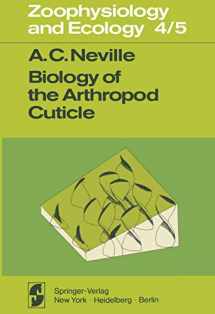
Biology of the Arthropod Cuticle (Zoophysiology, 4/5)
ISBN-13:
9783642809125
ISBN-10:
364280912X
Edition:
Softcover reprint of the original 1st ed. 1975
Author:
A.C. Neville
Publication date:
2011
Publisher:
Springer
Format:
Paperback
466 pages
Category:
Biology
,
Zoology
,
Biological Sciences
FREE US shipping
Book details
ISBN-13:
9783642809125
ISBN-10:
364280912X
Edition:
Softcover reprint of the original 1st ed. 1975
Author:
A.C. Neville
Publication date:
2011
Publisher:
Springer
Format:
Paperback
466 pages
Category:
Biology
,
Zoology
,
Biological Sciences
Summary
Biology of the Arthropod Cuticle (Zoophysiology, 4/5) (ISBN-13: 9783642809125 and ISBN-10: 364280912X), written by authors
A.C. Neville, was published by Springer in 2011.
With an overall rating of 3.7 stars, it's a notable title among other
Biology
(Zoology, Biological Sciences) books. You can easily purchase or rent Biology of the Arthropod Cuticle (Zoophysiology, 4/5) (Paperback) from BooksRun,
along with many other new and used
Biology
books
and textbooks.
And, if you're looking to sell your copy, our current buyback offer is $0.3.
Description
Mention the words 'arthropod cuticle' to most biologists and they usually provoke a glazed expression. This is because the cuticle is commonly regarded as an inert substance. It is hoped that this book will dispel this fallacy. The study of cuticle in its proper context now involves many of the wider aspects of biology which are currently in vogue (e. g. how a hormone like ecdyson induces a specific enzyme like dopa decarboxylase; the unsolved major problem of cell gradient and polarity; the involvement of cyclic AMP in hormonal mechanisms; the extra cellular control of cuticular enzymes, of the mechanical proper ties of cuticle structural proteins, and of the orientation of fibrous molecules; and the relation of chromosome puffing to the synthesis of specific proteins). Studies on cuticle demand a variety of techniques, and examples of the following are illustrated in this book (fluorescence, phase contrast, polariza tion and Nomarski interference microscopy; infrared absorp tion; transmission and scanning electron microscopy; autora diography analyzed by electron microscopy; negative staining in the electron microscope; optical diffraction, high angle X-ray diffraction, low angle X -ray diffraction and selected area electron diffraction). I am well aware that the biophysical parts of this book are less incomplete than other aspects. A developmental biologist or a biochemist would have further elaborated other parts ofthe subject matter. Only one previous author, RICHARDS (1951)hasdevoted a book to arthropod cuticle.


We would LOVE it if you could help us and other readers by reviewing the book
Book review

Congratulations! We have received your book review.
{user}
{createdAt}
by {truncated_author}


